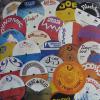All different eras too:
ska 1962-65
Ska is a form of Jamaican music which began in the late 1950s. Combining elements of traditional mento and calypso with an American jazz and rhythm and blues sound, it was a precursor in Jamaica to rocksteady and later reggae. It is the predominant form of music listened to by the Rudeboy, Mod, and Skinhead movements, amongst others
rocksteady 1966-67
Rocksteady is the name given to a style of music popular in Jamaica between 1966 and 1968. The term comes from a dance style which Alton Ellis named in his recording "Rock Steady". The Rocksteady dance was a more relaxed affair than the earlier, more frantic ska moves.
A successor to ska, and a precursor to reggae, rocksteady saw the flowering of Jamaican vocal harmony groups such as The Gaylads, The Kingstonians, Toots & the Maytals and The Paragons. Key musical differences between ska and rocksteady were a more relaxed tempo, a diminished use of horns, and a change of the role of the bass. With ska the bass had tended to play quarter notes in an even "walking" style, but in rocksteady the bass part became more broken-up and syncopated, using aggressive, repetitive lines which were often doubled by a guitar.
Rocksteady arose at a time when young people from the Jamaican countryside were flooding into the urban ghettos of Kingston, in neighborhoods known as Riverton City, Greenwich Town and, most notoriously, Trenchtown. Though much of the country was optimistic about their future in the immediate post-independence climate, these poverty-stricken youths did not share in this sentiment. They eschewed the frenetic energy of ska, and the cultural mores of the time, many becoming delinquents who despite being anti-social, exuded a certain coolness and style. These unruly youths became known as rude boys. The rude boy phenomenon had existed in the ska period but was expressed more obviously during the rocksteady era in songs such as "Rude Boy Gone A Jail" by the Clarendonians, "No Good Rudie" by Justin Hinds & the Dominoes, "Don't Be Rude" by the Rulers. Though Alton Ellis is generally said to be the father of rocksteady for his hit "Girl I've Got a Date", other candidates for the first rocksteady single include "Take It Easy" by Hopeton Lewis, "Tougher Than Tough" by Derrick Morgan and "Hold Them" by Roy Shirley.
The record producer Duke Reid released Alton Ellis' "Girl I've Got a Date", on his Treasure Isle label, as well as recordings by The Techniques, The Silvertones, The Jamaicans and The Paragons; his work with these groups helped establish the vocal sound of rocksteady. In addition to the harmony trios, solo artists such as Delroy Wilson, Bob Andy and Ken Boothe were also hugely popular. Rocksteady lyrics tended to deal with love, rude boys, or were simple dance tunes, and while singers sometimes covered American hits, many Jamaican artists composed fine original songs. Musicians who were crucial in creating the music included guitarist Lynn Taitt, keyboard player Jackie Mittoo, drummer Winston Grennan, bassist Jackie Jackson and saxophonist Tommy McCook.
Several factors contributed to the growth of rocksteady into reggae in the late 1960s. The emigration to Canada of key musical arrangers Jackie Mittoo and Lynn Taitt along with the modernization of Jamaican studio technology had a marked affect on the sound and style of the recordings. Musically, bass patterns became more complex and increasingly dominated the arrangements, as the piano gave way to the electric organ and the horns faded even farther into the background. A scratchier, percussive rhythm guitar and a more precise and intricate style of drumming came into prominence. Lyrical content changed, as the honeymoon of Jamaican independence had ended by the late 1960s with the average Jamaican seeing little relief from widespread poverty. By the early 1970s as the Rastafarian movement gained in popularity, songs tended to be focused less on romance and more on black consciousness, politics and protest. Although rocksteady was a short-lived phase of Jamaican popular music, it was hugely influential to the reggae and dancehall styles that followed, and many basslines originally created for rocksteady songs continue to be recycled and used in contemporary Jamaican music.
reggae 1968-70
from wikipedia


